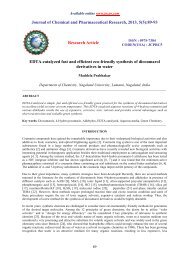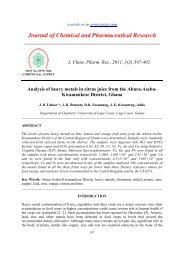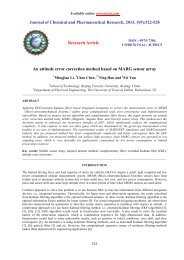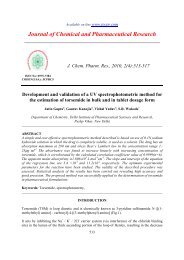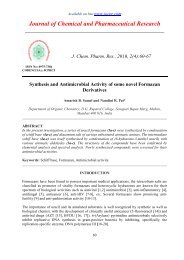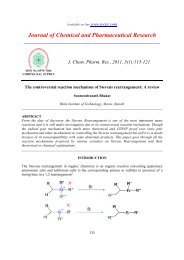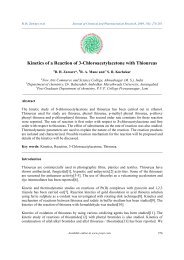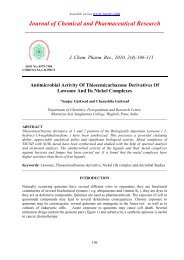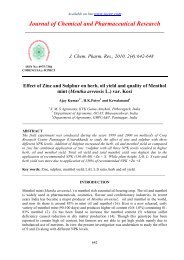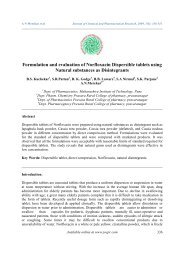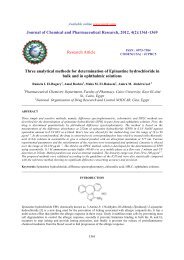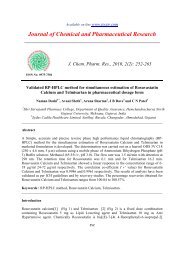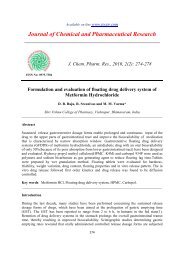Microwave Assisted Solvent Free Synthesis of Bioactive Quinazolin
Microwave Assisted Solvent Free Synthesis of Bioactive Quinazolin
Microwave Assisted Solvent Free Synthesis of Bioactive Quinazolin
Create successful ePaper yourself
Turn your PDF publications into a flip-book with our unique Google optimized e-Paper software.
Available on line www.jocpr.comJournal <strong>of</strong> Chemical and Pharmaceutical Research__________________________________________________J. Chem. Pharm. Res., 2010, 2(4):576-579ISSN No: 0975-7384CODEN(USA): JCPRC5<strong>Microwave</strong> <strong>Assisted</strong> <strong>Solvent</strong> <strong>Free</strong> <strong>Synthesis</strong> <strong>of</strong> <strong>Bioactive</strong> <strong>Quinazolin</strong>-4-(3H)-one CompoundsPriyanka S. Shisode and Pramod P. Mahulikar*School <strong>of</strong> Chemical Sciences, North Maharashtra University, Jalgaon, (M. S.), India______________________________________________________________________________ABSTRACT<strong>Quinazolin</strong>-4-(3H)-ones and their derivatives are the important class <strong>of</strong> heterocycles that are <strong>of</strong>considerable interest due to their diverse range <strong>of</strong> biological properties. In present investigationa simple, facile, rapid and solvent free microwave enhanced synthesis <strong>of</strong> quinazolin-4-(3H)-onesin excellent yield has been developed.Keywords: <strong>Quinazolin</strong>-4-(3H)-ones, <strong>Microwave</strong>, <strong>Solvent</strong> free synthesis, Bioactivity.______________________________________________________________________________INTRODUCTIONCondensed heterocyclic systems with a partially or a completely reduced pyrimidine nucleus are<strong>of</strong> interest, since they display valuable pharmaceutical activities. There has been an increasinginterest in the chemistry <strong>of</strong> 4-(3H)-quinazolinones because <strong>of</strong> their potent biological significance.Many <strong>of</strong> them show antifungal, antibacterial, anticancer, anti inflammatory, anticonvulsant,antitubercular activity and antiproliferative activities as well as inhibitory effects for thymidylatesynthase and poly-(ADP-ribose) polymerase (PARP) [1,2].An increasing interest in the synthesis <strong>of</strong> libraries <strong>of</strong> biologically active 4-(3H)-quinazolinonesencouraged the chemists to search for environmentally benign synthetic approaches [3,4]. In thepresent work, we have developed the synthesis <strong>of</strong> 4-(3H)-quinazolinones under microwaveirradiation using solid support.EXPERIMENTAL SECTIONAll chemicals used were synthetic grade (s. d. Fine Chemicals Ltd., Mumbai, India). Theanthranilic acid was prepared in laboratory from phthalimide using sodium hypobromite [5]. The576
Pramod P. Mahulikar et al J. Chem. Pharm. Res., 2010, 2(4):576-579_____________________________________________________________________________products were characterized by comparing their physical constants with authentic samples. Themelting points were determined by open capillary method and are uncorrected. 1 H NMR spectrawere recorded on Bruker FT 300 (300 MHz) using TMS as an internal standard and chemicalshift are expressed in δ (ppm). IR spectra were recorded on Perkin-Elmer (Spectra One) FTIRspectrophotometer in the form <strong>of</strong> KBr pellets.a) <strong>Synthesis</strong> <strong>of</strong> 2-amino-4-chloro phenylthiazole (3)ClOCCH 3+SH 2N C NH 2Silica gel3 minClSNMW,1 2 3A mixture <strong>of</strong> p-chloroacetophenone (1, 0.01 m) and thiourea (2, 0.02 m) was dissolved inmethanol (5 ml) and this mixture was supported on silica gel (5 g) taken in 100 ml beaker. It wasthen irradiated under microwaves at pulse <strong>of</strong> 10 sec. for 3 min at power level 40. The progress <strong>of</strong>reaction was monitored by silica gel TLC (hexane: ethyl acetate, 9:1). Ethanol (10 ml) was thenadded to reaction content, stirred and filtered. The solvent was removed from filtrate to afford 2-amino-4-chlorophenylthiazole (3), which was recrystallized from ethanol to give colourlessneedles <strong>of</strong> 3, yield 91 %, m.p.98-99 0 ( lit. [1], m. p. 99 0 C ), IR (KBr, cm -1 ): 3350 (NH 2 ), 2922,2626 (CH <strong>of</strong> thiazole), 1461 (Ar C=C), 1190 (C-S).b) <strong>Synthesis</strong> <strong>of</strong> N-acetyl anthranilic acid (6)NH 2COOHNH 2+ClOCH 3Silica gelMW , 4-5 minCOOHNHCOCH 34 5 6Anthranilic acid (4, 0.06 m) was dissolved in dichloromethane (5 ml) and acetyl chloride (5, 0.06m) was added to it and this mixture was supported on silica gel (6 g) taken in 100 ml beaker.Then it was irradiated under microwaves for 4-5 min at power level 30. The progress <strong>of</strong> reactionwas monitored by silica gel TLC (hexane: ethyl acetate, 9:1). Acetone (10 ml) was added to it,stirred and filtered. The solvent from filtrate was evaporated to afford the solid product (6),which was recrystallized from acetone-ethanol mixture, yield 94%, m.p. 168-169 0 C (lit. [1],m.p.169 0 C), IR (KBr, cm -1 ) 3500 (OH),3300, (NH 2 ), 3010 (Ar C-H), 2960 (alkyl C-H),1680(C=O), 1590(Ar C=C).c) <strong>Synthesis</strong> <strong>of</strong> 2-methyl 3-(4-(4-chlorophenyl) thiazol-2-yl) quinazolin-4-(3H)-one (7)6COOH+NHCOCH 3ClSNNH 2Silica GelMW,4 min3 7ONNNCH 3SClA mixture <strong>of</strong> 6 (0.01m) and 3 (0.01m) was dissolved in dry ethanol (5 ml) containing K 2 CO 3 (1g) and then supported on silica gel (5 g) in 100 ml beaker. It was irradiated under microwaves577
Pramod P. Mahulikar et al J. Chem. Pharm. Res., 2010, 2(4):576-579_____________________________________________________________________________for 4 min at the power level 40. The progress <strong>of</strong> reaction was monitored by silica gel TLC(hexane: ethyl acetate 9:1). Ethanol (10 ml) was added, stirred and filtered. The solvent wasremoved from filtrate to give crude product 7, which was recrystallized from ethanol, yield 93%,m.p. 213-215 0 C (lit. [1], m. p.215 0 C), IR (KBr, cm -1 ) 3026 (Ar C-H), 2959 (alkyl C-H),1660(C=O), 1610 (C=N), 1525 (C-N), 1191 (C-S).d) <strong>Synthesis</strong> <strong>of</strong> 2-bromomethyl 3-(4-(4-chlorophenyl) thiazol-2-yl)-quinazolin-4-(3H)-one(8) [5]ONNNCH 3SClNBSONNNSCH 2Br78A mixture <strong>of</strong> 7 (0.06 m), N- bromo succinamide ( 0.02 m), ethanol (5 ml) and benzoyl peroxide(about 0.5 mg) was taken in 50 ml round bottom flask fitted with a reflux condenser. Thereaction mixture was heated on water bath under reflux unit all NBS converted to succinamide(which floats as dispersion in solvent).The contents were cooled, filtered under suction andresidue was washed with ethanol (10 ml). Removal <strong>of</strong> ethanol from filtrate afforded the product8, yield 94%, m. p.201-202 0 C (lit. [1], m. p. 203 0 C ), 1 H NMR (DMSO-d 6, δ ppm ): 2.61 (s, 2H,CH 2 ) , 6.42-7.20 (m,8H, Ar H), 7.20, (m, 1H, thiazole CH), IR (KBr, cm -1 ): 3043, 3010 (Ar C-H), 2994 (alkyl C-H), 1670(C=O), 1600 (C=N), 1525 (C-N), 1200(C-S).Compound( 9 )Table 1: Synthesized 4-(3H)-quinazolinones (9 a - j)Substitute( R )ReactionTime(min.)Yield (%)MW assisted(Conventional)m. p.( 0 C)(lit 1-3 . m. p. 0 C)a -C 6 H 4 Cl 4 93 (52) 55 (55)b -C 6 H 4 NO 2 5 96 (54) 123 (123)c -C 6 H 4 CH 3 7 91 (52) 138 (139)d -C 6H 4OCH 3 6 93 (57) 155 (156)eOHN 3 94 (65) 84 (85)ClfNN7 90 (56) 149 (150)g COOH 5 93 (47) 147 (147)hOHCOOH6 90 (60) 122 (123)578
Pramod P. Mahulikar et al J. Chem. Pharm. Res., 2010, 2(4):576-579_____________________________________________________________________________e) General procedure for synthesis <strong>of</strong> 2-aminomethyl 3-(4-(4-chloro phenyl) thiazol-2-yl)quinazoline-4(3H) one (9)ON8NNSCH 2Br+ClRNH 2silica gelMW, 2-7 min.ONNNSCH 2NHRA mixture <strong>of</strong> 8 (0.01 m), relevant amine (0.01 m) and pyridine (0.4 ml) was dissolved in aceticacid (5 ml). This reaction mixture was supported on silica gel (5 g) and irradiated undermicrowaves at power level 30 for 3 min. The progress <strong>of</strong> reaction was monitored with silica gelT. L. C. (hexane: ethyl acetate, 8:2). Ethanol (10 ml) was added, stirred and filtered. The solventwas removed from filtrate to afford crude products (9 a – h, Table 1), which were Recrystallizedfrom ethanol.9a : 1 H NMR (DMSO-d 6, δ ppm): 2.61 (s, 2H, CH 2 ) , 4.80 (s, 1H, NH), 6.42-7.24 (m,12H, Ar Hand 1H, thiazole CH).9d : 1 H NMR (DMSO-d 6, δ ppm): 2.64, (s, 2H, CH 2 ), 3.66, (s, 3H, OCH 3 ), 4.84(s ,1H, NH),6.44-7.62, (m, 8H, Ar H and 1H, thiazole CH).9g: 1 H NMR (DMSO-d 6, δ ppm): 1.24, (s, 2H, CH 2 ), 3.20, (s 1H, NH), 9.01, (bs, 1H, COOH),6.20-7.50, (m, 12H, Ar H and 1H, thiazole CH).(9 a - h): IR (KBr, cm -1 ): 3560-3200 (OH), 3130-3006 (Ar C-H ), 2998-2959 (alkyl C-H), 1672-1660(C=O), 1610-1600 (C=N), 1525-1520 (C-N), 1200-1990(C-S).CONCLUSIONEnvironmentally benign approach for solvent free synthesis <strong>of</strong> biologically active 4-(3H)-quinazolinone compounds has been developed using microwave and silica gel (60-120 mesh) assolid support. The yield and purity <strong>of</strong> products are excellent as compared with conventionalroutes. The reactions were rapid and isolation <strong>of</strong> products by simple filtration followed byevaporation <strong>of</strong> solvent is an important feature <strong>of</strong> the developed methodology. This greenermethodology will be useful in synthesis <strong>of</strong> libraries <strong>of</strong> compounds having such differentbioactivities as pharmaceuticals and agrochemicals.REFERENCES[1] SR Pattan; VV Krishna Reddy; FV Manvi; BG Desaiand; AR Bhat. Indian J. Chem., 2006,45B, 1778- 1781.[2] AE Mourad; AA Aly; HH Farag; EA Bashr. Beilstein J. Org. Chem., 2007, 3-11.[3] K Arya; M Agarwal. Bioorg. Med. Chem. Lett., 2007, 17, 86–93.[4] AR Desai; and KR. Desai. ARKIVOC, 2005, (xiii), 98-108.[5] BS Furniss; AJ Hannaford; PWG Smith; AR Tatchell. Vogel’s Textbook <strong>of</strong> Practical OrganicChemistry, 5 th Edition, ELBS, Longman, 1989, 578-579 & 898-899.9Cl579



